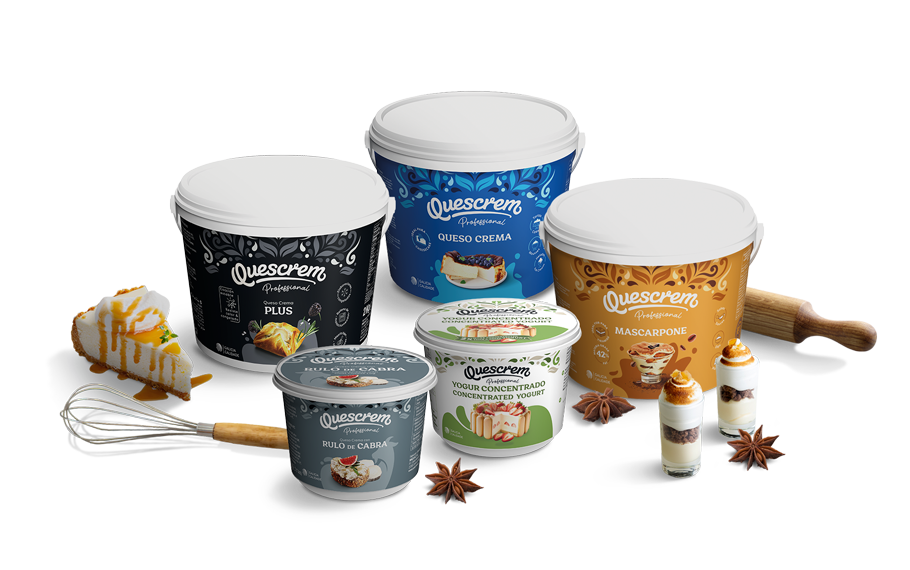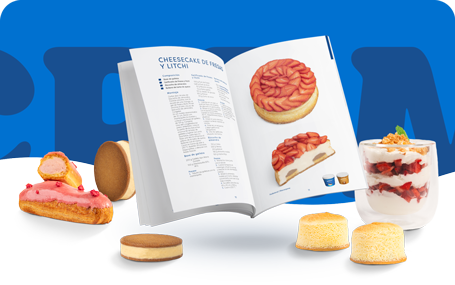La fabrication de glaces artisanales dans votre restaurant ou votre atelier peut être un bon moyen de vous différencier et d’offrir une valeur ajoutée à vos clients. Que vous utilisiez la glace pour accompagner des plats sucrés ou salés, ou qu’elle fasse partie intégrante de vos desserts, la fabrication de votre propre glace vous permettra d’offrir à vos clients une variété de saveurs unique et différente.
Grâce à l’évolution des techniques et équipements gastronomiques, la crème glacée est présente sur le marché depuis des années, non seulement chez les glaciers, mais aussi dans les menus sucrés et salés des restaurants, bars et cafés du monde entier. Dans le secteur de l’hôtellerie et de la restauration, les glaces étaient souvent achetées toutes prêtes pour être proposées aux clients comme dessert, car il existe sur le marché de bonnes glaces industrielles et artisanales pour les entreprises de l’hôtellerie et de la restauration. Toutefois, les restaurants ont de plus en plus tendance à fabriquer leurs propres glaces , en raison de l’intérêt croissant des consommateurs pour les glaces artisanales, les desserts faits maison et les propositions originales.
L’apparition de machines de restauration pour la fabrication de glaces et de modules de fabrication de glaces artisanales dans les programmes de formation des principales écoles d’hôtellerie et de restauration, telles que la Masterclass de glace artisanale à l’École supérieure d’hôtellerie de Bilbao, le Cours intensif de formation à la glace du Basque Culinary Center ou le Cours d’expert en production de glace à l’Université d’Alicante, permettent aux professionnels de la cuisine et de la pâtisserie de fabriquer leurs propres glaces.
Si vous envisagez d’inclure la production de glaces dans votre restaurant et que vous ne savez pas par où commencer pour planifier sa production et l’intégrer dans le style de la cuisine proposée par votre restaurant, vous êtes au bon endroit. Rejoignez-nous tout au long de cet article pour passer en revue tous les points que vous devez garder à l’esprit lorsque vous intégrez une glace maison dans votre menu : les types de glace, l’importance du choix des ingrédients, la manière de la vendre à vos clients, et en outre, quelques conseils et inspirations via des recettes qui vous seront très utiles pour prendre votre décision.
Types de glaces
Commençons par le commencement : qu’appelle-t-on une crème glacée ? En bref, une crème glacée est une préparation alimentaire composée de divers ingrédients qui subissent un processus de barattage puis de refroidissement pour les amener à un état semi-liquide, semi-solide ou solide qui doit être conservé au froid jusqu’au moment de la consommation. Les ingrédients et leur équilibre dans la formule détermineront le type de crème glacée qui en résultera, ce qui permet de distinguer différents types de préparations de glaces :- Les granités. Il s’agit de produits semi-liquides contenant au minimum 10 % d’extrait sec. Ils ne contiennent pas d’air et leur température de service se situe entre -2 et -4 ºC. L’épaisseur des cristaux de glace qu’ils contiennent est liée à la quantité de sucres dans leur formulation et au degré de refroidissement qu’ils subissent.
- Les glaces à l’eau. Ce sont sans doute les préparations glacées les plus simples dans leur version à base de sucre et d’eau aromatisée (avec des fruits, des herbes aromatiques, etc.) que l’on incorpore dans un moule à sucettes glacées, dans lequel on insère un cure-dent. Une fois solidifiées, on les démoule et on les conserve à une température qui garantit leur structure et leur forme jusqu’au moment de les servir. Si l’on souhaite une texture plus crémeuse, on peut ajouter des matières grasses provenant du lait, de la crème, du fromage à la crème ou des jaunes d’œuf.
- Les sorbets sont des crèmes glacées qui ne contiennent pas de matières grasses mais de l’eau et un minimum d’environ 15 % de fruits, de jus, de concentrés et parfois d’alcool, ainsi que 20 % ou plus d’extrait sec total. Au cours du processus de production, ils sont battus pour incorporer une certaine quantité d’air et leur donner une texture suffisamment plastique pour être servis et consommés. Contrairement aux crèmes glacées, qui ont une durée de vie plus longue en bouche, les sorbets sont des produits désaltérants qui apportent un rafraîchissement immédiat. De plus en plus de chefs les servent en entrée, en version salée, en les associant à des ingrédients estivaux (herbes fraîches, fromage de chèvre, paprika, etc.).
- Les crèmes glacées présentent une composition contenant des matières grasses, de la poudre de lait et des protéines de lait. Une certaine quantité d’air est incorporée au cours du processus de production. Bien qu’elles soient soumises à de basses températures, elles doivent avoir une texture crémeuse et une plasticité suffisante pour faciliter le service et la consommation. La crème glacée est généralement moins rafraîchissante que le sorbet, mais elle reste plus longtemps en bouche et sa palatabilité la rend appétissante à tout moment de l’année. Sa composition donne une impression de consistance, un véritable dessert ou un accompagnement gourmand de plats et d’entrées. Comme le sorbet, elle peut être préparée en version sucrée ou salée.
Le rôle des ingrédients dans la fabrication des glaces classiques
La fabrication d’une glace implique une équation de pure alchimie qui nécessite une connaissance approfondie de ses ingrédients et de sa formulation, car la réussite d’une recette de glace dépend du bon équilibre des matières premières. Par conséquent, pour faire une bonne glace, il faut connaître les ingrédients et la composition de vos recettes, et il faut de la pratique pour trouver le bon équilibre entre les différents ingrédients et leurs proportions dans la recette. En général, une crème glacée classique contient environ 60 à 64 % d’eau et 36 à 42 % de matière sèche totale provenant de la somme de tous les ingrédients. Sans entrer dans les détails de sa fabrication, une recette de crème glacée de base se compose d’eau (cristaux de glace) et d’ingrédients secs, notamment des matières grasses, des extraits secs de lait écrémé, d’autres ingrédients tels que des émulsifiants et des stabilisants, ainsi que du sucre. Nous allons examiner ci-dessous chacun des ingrédients de base d’une recette de base de crème glacée :- Matière grasse laitière
- Solides non gras du lait
- Émulsifiants et stabilisants
- Sucres
- Ingrédients pour ajouter de la saveur
Le fromage à la crème idéal pour la formulation de la crème glacée
Le fromage à la crème est un ingrédient culinaire polyvalent qui apporte une valeur ajoutée à un grand nombre de recettes de crèmes glacées. En général, le fromage à la crème apporte de la saveur, des matières grasses, des protéines et une fonction stabilisatrice à la crème glacée. En particulier, les fromages à la crème et mascarpones Quescrem sont parfaits pour la fabrication de glaces :- Leur teneur en protéines de lait donne de la consistance, de l’émulsification et de la stabilité au mélange de crème glacée.
- Leur équilibre entre les matières grasses et les protéines leur confère une grande stabilité lors de la transformation à froid et de la congélation.
- Ils permettent d’incorporer facilement une grande variété de parfums originaux de crème glacée de différentes intensités : chèvre, yaourt, gâteau au fromage, tiramisu, etc.
- Ils permettent de proposer des glaces sans lactose, allégées, hyperprotéinées, biologiques et « clean label ».
- Fromage à la crème Naturel avec une saveur douce et facile à combiner avec n’importe quel ingrédient, et disponible dans des versions Sans lactose, Light et +PRO, qui est idéal pour préparer des parfums tels que la crème glacée au gâteau au fromage.
- La gamme Quescrem comprend des saveurs telles que la bûche de chèvre, le fromage bleu ou l’ail et les fines herbes, qui permet de produire des glaces aromatisées de manière simple avec des ingrédients naturels et un minimum de manipulation.
- Le seul yaourt conçu pour la cuisine et le premier et unique kéfir à tartiner sur le marché. Deux produits différents qui, grâce à leur composition et à leur saveur, vous permettront de créer des tendances irrésistibles en matière de crème glacée.
- Mascarpone Quescrem, qui contient 42 % de matières grasses et est idéal pour les glaces très crémeuses et les saveurs spéciales telles que le tiramisu. Il présente une grande stabilité et une bonne capacité d’aération. Il est également disponible dans une version sans lactose.
- Quescrem Plus, qui permet de réaliser des crèmes glacées simples dans des robots culinaires de type Thermomix, sans avoir besoin d’une sorbetière.
Les meilleures recettes de crème glacée.
Vous avez besoin d’inspiration pour introduire vos propres glaces dans votre menu ? Voici quelques idées pour proposer des glaces dans votre menu, avec différentes combinaisons de saveurs que vous pourrez adapter aux goûts de votre clientèle ou auxdernières tendances gastronomiques du moment. Pour commencer, vous pouvez préparer une base de crème glacée avec l’une des variétés de Quescrem qui servira à accompagner différents types de plats. Une glace au fromage à la crème en version sucrée ou salée, une glace au fromage de chèvre pour les viandes, une glace à l’ail et aux fines herbes pour les poissons, une glace au yaourt pour les cornichons et les salaisons, une glace au mascarpone pour donner une touche chic à tous les plats…… Mais vous pouvez aussi essayer certaines de ces combinaisons :- Glace à la bûche de chèvre avec confiture de figues et noix confites. Une glace parfaite en accompagnement, le contraste de la douceur avec la bûche de chèvre Quescrem sera inoubliable. L’utilisation de la bûche de chèvre dans une crème glacée attirera l’attention du consommateur à la recherche de nouveauté, sans pour autant alourdir la charge de travail de votre cuisine. Grâce au format crème de Quescrem à la bûche de chèvre, vous n’avez pas besoin de travailler le fromage au préalable pour l’intégrer à la glace. En outre, la combinaison de la Bûche de chèvre avec des figues et des noix confites vous permettra de proposer la glace seule ou en accompagnement de desserts ou de plats chauds.
- Glace au kéfir aux myrtilles. La combinaison du kéfir aux myrtilles avec la pâte à tartiner au kéfir de Quescrem dans sa version glacée apportera une touche de fraîcheur saine à votre menu. Le kéfir est un produit laitier largement consommé de nos jours, mais son format traditionnel empêcherait de percevoir le goût du kéfir lorsqu’il est utilisé dans des préparations de crème glacée, en raison de la faible quantité de produit pouvant être ajoutée à la formule. D’autre part, le kéfir à tartiner Quescrem, qui a une teneur élevée en protéines, permettrait de reformuler votre crème glacée afin d’ajouter davantage de kéfir au mélange et d’obtenir ainsi une crème glacée au goût intense de kéfir. Ce type de glace ne figure généralement pas sur les cartes des restaurants, ce qui vous permettra de vous démarquer de la concurrence avec une combinaison aussi originale que le kéfir aux myrtilles.
- Glace au mascarpone et chocolat blanc torréfié. Le mascarpone, considéré par beaucoup comme un produit gastronomique, ajoutera une touche d’onctuosité à votre glace et vous permettra de l’associer à des saveurs salées ou sucrées. Dans cet exemple, nous l’avons associé à du chocolat blanc torréfié, ce qui permet de tirer le meilleur parti de l’arôme du chocolat tout en apportant une couleur noisette à la crème glacée.
- Glace au tiramisu sans lactose. Les allergies et intolérances alimentaires sont à l’ordre du jour, et c’est un atout pour votre entreprise que de proposer des alternatives appétissantes à ce type de clients. Bien qu’il existe une grande variété de glaces sans lactose, la saveur tiramisu n’est pas très répandue, car l’offre de mascarpone sans lactose est limitée. Le mascarpone Quescrem sans lactose, grâce à son onctuosité, donnera à votre glace au tiramisu sans lactose l’aspect d’une glace traditionnelle.
- Glace au yaourt, citron vert et framboises. Cette glace au yaourt, citron vert et framboises est un choix idéal pour un dessert ou un pré-dessert rafraîchissant. La glace au yaourt est également très populaire parce qu’elle est perçue comme un aliment léger et sain. Nous accompagnons cette crème glacée maison d’une génoise à la framboise comme garniture, d’une sauce au yaourt à la framboise et d’un croustillant au chocolat blanc et à la framboise lyophilisée. Pour sa préparation, nous utilisons le Yaourt culinaire Quescrem, parfait pour les formulations de crème glacée en raison de son équilibre entre matières grasses et protéines, qui n’est pas altéré par l’ajout d’acides, et dont la saveur de yaourt est aussi rafraîchissante qu’intense.
- Glace au gâteau au fromage. Une crème glacée au goût d’un des desserts préférés du public, le gâteau au fromage. Bien qu’il s’agisse d’un parfum très courant, on trouve rarement de telles glaces faites maison. Quescrem Professionnel a une saveur laitière très distincte qui rappelle le fromage à la crème grâce à son acidité, contrairement à d’autres fromages à la crème qui ont un goût plus beurré ou crémeux. Cela permet à son goût de ressortir sans se perdre dans les autres ingrédients de la formule. En outre, comme pour le gâteau au fromage classique, la glace au gâteau au fromage permet de jouer avec les garnitures que l’on ajoute à la fin, avec différents arômes de fruits et ingrédients secs tels que le crumble aux noix, les biscuits épicés, etc.
- Glace salée au yaourt et à la mangue épicée. Une option très intéressante consiste à préparer des glaces attrayantes pour les clients. Si nous devons fabriquer notre propre glace, quelle meilleure façon de mettre en valeur notre travail qu’en préparant une glace qui sort de l’ordinaire ? La mangue est associée à des touches épicées dans de nombreuses cuisines du monde, tout comme le yaourt, présent dans quantité de plats asiatiques tels que les currys. Il s’agit d’un mélange de saveurs intéressant pour le gourmet, qui peut être utilisé pour accompagner divers plats salés et sucrés. Le Yaourt culinaire Quescrem utilisé dans la recette conserve une saveur intense de yaourt avec sa touche aigre caractéristique, grâce à sa composition équilibrée entre matières grasses et protéines, ce qui le rend parfait pour une utilisation dans la crème glacée, permettant d’ajouter une quantité considérable de produit.
- Glace au saumon et au fromage à la crème. Une combinaison présente sur la grande majorité des plateaux d’appétitifs, présentée dans un format aussi différent que la crème glacée. Cette glace salée peut être utilisée pour accompagner de nombreux plats tels qu’une crème de légumes, par exemple de fenouil et de panais, créant ainsi à la fois intérêt et surprise.
- Crème glacée Quescrem Plus et vin rouge. Cette glace au fromage et au vin rouge accompagnera parfaitement les plats sucrés, comme une poire rôtie caramélisée, ainsi que les plats salés, comme des légumes rôtis. Cette recette originale permet de jouer avec le type de vin et la variété de raisin, vous donnant ainsi la possibilité d’associer le vin au plat dans un format très différent et original. L’utilisation de Quescrem Plus dans la recette nous donnera également l’avantage de préparer la crème glacée à l’aide d’un robot culinaire, sans avoir à utiliser une sorbetière.
Comment augmenter les ventes de glaces dans votre établissement ?
Nous avons expliqué que la crème glacée peut être ajoutée à un plat sucré ou salé, mais qu’elle peut aussi être un dessert en soi. L’ajout d’une touche de crème glacée à vos plats peut contribuer à accroître l’intérêt du consommateur pour le plat lui-même, car sa simple apparition dans le nom du plat sur le menu peut être irrésistible. Par conséquent, une glace artisanale aux saveurs intéressantes peut vous aider à mieux vendre un plat : elle vous permet en effet de mettre en valeur un plat auquel le client ne s’attend pas et de le surprendre, par exemple avec un carpaccio de saumon accompagné de glace au yaourt et à l’aneth, une quenelle de glace au mascarpone avec un steak, ou une glace au concombre et au citron accompagnant une salade. Une bonne gamme de glaces artisanales peut vous aider à vendre plus de glaces en tant que dessert. Les ventes de glaces sont généralement liées à la température. Ainsi, en été, les glaces se vendent facilement, mais dès l’arrivée de l’hiver, les ventes de glaces diminuent. Comment vendre plus de glaces dans votre restaurant à tout moment de l’année ? Voici quelques stratégies pour y parvenir :- Analyser les attentes de vos clients
- Proposer une quantité suffisante de parfums de crème glacée
- Créer de nouvelles expériences gustatives et de nouveaux formats
- Adapter la carte des desserts à chaque saison
- S’engager en faveur des produits naturels, artisanaux et locaux
- Donner de la visibilité à votre offre de glaces
- Toujours recommander les desserts
- Connaître les heures de pointe et les heures creuses, et agir en conséquence



